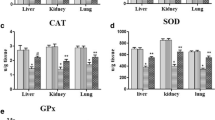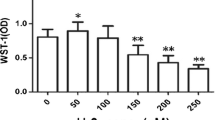Abstract
In order to understand the stress response of systemic organs to severe burn injury, the induction of 72-kD heat shock protein (HSP72) in various organs (brain, hypophysis, lung, heart, liver, pancreas, spleen, kidney, adrenal gland, and skeletal muscle) was investigated in rats with severe burns. A full-thickness burn was induced on the rats' skin by immersing the rats in hot water (90° C) for 3 s. At 0, 24, and 48 h after the burn injury, the HSP72 expression of various organs was examined using the Western blot analysis. At 24 h after the burn injury, the level of HSP72 had increased in the hypophysis, lung, heart, and kidney. In all organs examined, the expression of HSP72 had increased at 48 h after the burn injury. The level of HSP72 was highest in the hypophysis (3.3-fold compared to the control), and lowest in the brain and adrenal gland (1.7-fold of the control) at 48 h after the burn injury. These results confirm that severe burn injury causes a stress response in systemic organs.
Similar content being viewed by others
References
Aikawa N, Martyn JA, Burke JF (1982) Pulmonary artery catheterization and thermodilution cardiac output determination in the management of critically burned patients. Am J Surg 135:811
Achauer BM, Allyn P, Furnas DW, Bartlett RH (1973) Pulmonary complications in burns: the major threat to the burn patient. Ann Surg 177:311
Baxter CR (1966) Serum myocardial depressant factor of burn shock. Surg Forum 17:1
Baxter CR, Shires T (1968) Physiological response to crystalloid resuscitation of severe burns. Ann NY Acad Sci 150:874
Blake MJ, Gershon D, Fargnoli J, Holbrook NJ (1990) Discordant expression of heat shock protein mRNA as in tissues of heat-stressed rats. J Biol Chem 265:15275
Blake MJ, Udelsman R, Feulner GJ, Norton DD, Holbrook NJ (1991) Stress-induced HSP70 expression in adrenal cortex: A glucocorticoid-sensitive, age-dependent response. Proc Natl Acad Sci USA 88:9873
Caldwell FT (1976) Energy metabolism following thermal burns. Arch Surg 111:181
Clark AS, Kelly RA, Mitch WE (1984) Systemic response to thermal injury in rats; Accelerated protein degradation and altered glucose utilization in muscle. J Clin Invest 74:888
Cosgrove JW, Brown IR (1983) Heat shock protein in mammalian brain and other organs after a physiologically relevant increase in body temperature induced by d-lysergic acid diethylamide. Proc Natl Acad Sci USA 80:569
Cuevas B, Kaufman AE, Fine JA (1973) Vasoactive agent in burns which produces fatal endotoxic shock. Surg Forum 24:39
Currie RW, White FP (1981) Trauma-induced protein in rat tissues: a physiological role for a “heat shock” protein? Science 214:72–73
Durkot MJ, Wolf RR (1981) Effects of adrenergic blockade on glucose kinetics in septic and burned guinea pigs. Am J Physiol 241:R222
Emami A, Schwarts JH, Borkan SC (1991) Transient ischemia or heat stress induces a cytoprotectant protein in rat kidney. Am J Physiol 260:F479
Gilmore JP, Handford SW (1956) Hemodynamic response of the dog to thermal radiation. J Appl Physiol 8:393
Knowlton AA, Brecher P, Apstein CS (1991) Rapid expression of heat shock protein in the rabbit after brief cardiac ischemia. J Clin Invest 87:139
Lindquist S (1986) The heat-shock response. Annu Rev Biochem 55:1151
Mivech NH, Monson JM, Hahn GM (1991) Expression of HSP-28 and three HSP-70 genes during the development and decay of thermotolerance in leukemic and nonleukemic human tumors. Cancer Res 51:6608
Moati F, Sepulchre C, Miskulin M, Huisman O, Moczar E, Robert A, Monteil R, Guilbaud J (1979) Biochemical and pharmacological properties of a cardiotoxic factor isolated from the blood serum of burned patients. J Pathol 127:147
Muramatsu T, Tada H, Kobayashi N, Yamaji M, Shirai T, Ohnishi T (1992) Induction of the 72-kD heat shock protein in organ-cultured normal human skin. J Invest Dermatol 98:786
Ogawa Y, Matsumoto K, Ofuji S (1977) Changes in adenine nucleotide and mitochondrial metabolism of the kidney of burned rats and their relation to insulin. J Lab Clin Med 90:457
Schlesinger MJ (1990) Heat shock proteins. J Biol Chem 265:12111
Seiye H (1946) The general adaptation syndrome and the diseases of adaptation. J Clin Endocrinol Metab 6:117
Sepulchre C, Moati F, Miskulin M, Husman O, Moczar E, Robert A, Monteil R, Guilbaud J (1979) Biochemical and pharmacological properties of a neurotoxic protein isolated from the blood serum of heavily burned patients. J Pathol 127:137
Udersman R, Blake MJ, Holbrook NJ (1991) Molecular response to surgical stress: Specific and simultaneous heat shock protein induction in the adrenal cortex, aorta, and vena cava. Surgery 110:1125
Udelsman R, Blake MJ, Stagg CA, Li D, Putney J, Holbrook NJ (1993) Vascular heat shock protein expression in respone to stress-endocrine and automatic regulation of this age-dependent response. J Clin Invest 91:465
Udelsman R, Goldstein Ds, Loriaux DL, Chrousos GP (1987) Catecholamine — glucocorticoid interactions during surgical stress. J Surg Res 43:539
Vass K, Welch WJ, Nowak TS (1988) Localization of 70-kDa stress protein induction in gerbil brain after ischemia. Acta Neuropathol 77:128
Vaughan GM, Becker RA, Allen JP, Goodwin CW, Pruitt BA, Mason AD (1982) Cortisol and corticotropin in burned patients. J Trauma 22:263
Volenec FJ, Clark GM, Mani MM, kyner J, Humphrey LJ (1979) Metabolic profiles of thermal trauma. Ann Surg 190:694
Welch WJ, Suhan JP (1986) Cellular and biochemical events in mammalian cells during and recovery from physiological stress. J Cell Biol 103:2035
Wilmore DW, Aulick LH, Mason AD, Pruitt BA (1977) Influence of the burn wound on local and systemic responses to injury. Ann Surg 186:444
Wilmore DW, Long JM, Mason AD, Skreen RW, Pruitt BA (1974) Mediator of hypermetabolic response to thermal injury. Ann Surg 180:653
Author information
Authors and Affiliations
Rights and permissions
About this article
Cite this article
Hatoko, M., Hirai, S., Tada, H. et al. HSP72 induction of systemic organs of rats after severe burn injury. Eur J Plast Surg 20, 136–140 (1997). https://doi.org/10.1007/BF01002047
Issue Date:
DOI: https://doi.org/10.1007/BF01002047




